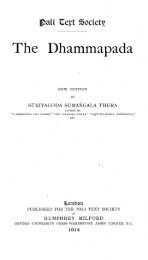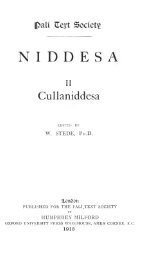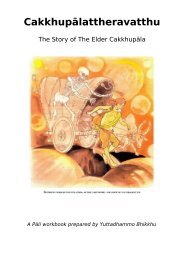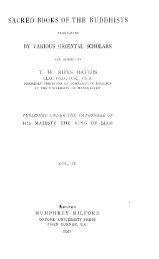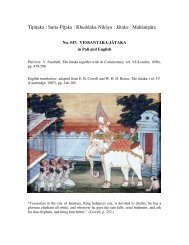Lessons In Practical Buddhism - Sirimangalo.Org
Lessons In Practical Buddhism - Sirimangalo.Org
Lessons In Practical Buddhism - Sirimangalo.Org
Create successful ePaper yourself
Turn your PDF publications into a flip-book with our unique Google optimized e-Paper software.
nature as something worth clinging to or not.<br />
“sati” would therefore be better translated as “recognition”,<br />
and this is how it has been referred to throughout this<br />
chapter. “sati”, in the context of the bojjhaṅgas is the<br />
deliberate and sustained recognition that allows one to see<br />
the objects of experience as they truly are.<br />
This explanation, which may seem a bit dry to the casual<br />
reader, is necessary to help us understand what the Buddha<br />
really meant in the Satipaṭṭḥāna Sutta, when he said, as<br />
quoted earlier, “when walking, one fully comprehends: ‘I am<br />
walking’.” It is clear that he did not mean that we should be<br />
aware that we are walking, since awareness is common to<br />
animals and ordinary humans alike. Simply recognizing that<br />
we are walking requires no meditative training whatsoever.<br />
To “fully comprehend” (pajānāti), one must cultivate the<br />
mental quality of “sati” or fortified recognition (thīra-saññā)<br />
by reminding oneself of the essential nature of the<br />
experience, as in “walking”. Reminding oneself in this way<br />
of what one already recognizes is equivalent to arresting the<br />
mind’s natural progression into projection, judgement,<br />
clinging, seeking, building up, and finally suffering.<br />
Another way of understanding this activity of fortifying one’s<br />
recognition is as a mantra, a traditional meditative tool that<br />
has been used for millennia by meditators both Buddhist and<br />
non. A mantra is used to focus the mind on an object,<br />
arresting the mind’s natural inclination to jump from object<br />
to object. It is traditionally used to focus on a conceptual<br />
object, something a meditator conjures up in the mind – a<br />
picture or a spiritual object like a god or angel.<br />
A mantra can, however, be used in much the same way in<br />
order to fix the mind on a real object as well, be it a physical<br />
sensation, a feeling, a thought, or an emotion. This is one<br />
way of understanding the word “sati” in the context of the<br />
Satipaṭṭhāna Sutta; it is the use of a mantra to stabilize and<br />
fortify one’s bare recognition of an experience for what it is,<br />
allowing one to see clearly without prejudice or projection<br />
and thus remove any misapprehensions based on delusion or<br />
ignorance.<br />
Once we cultivate sati, our minds will naturally incline<br />
58



